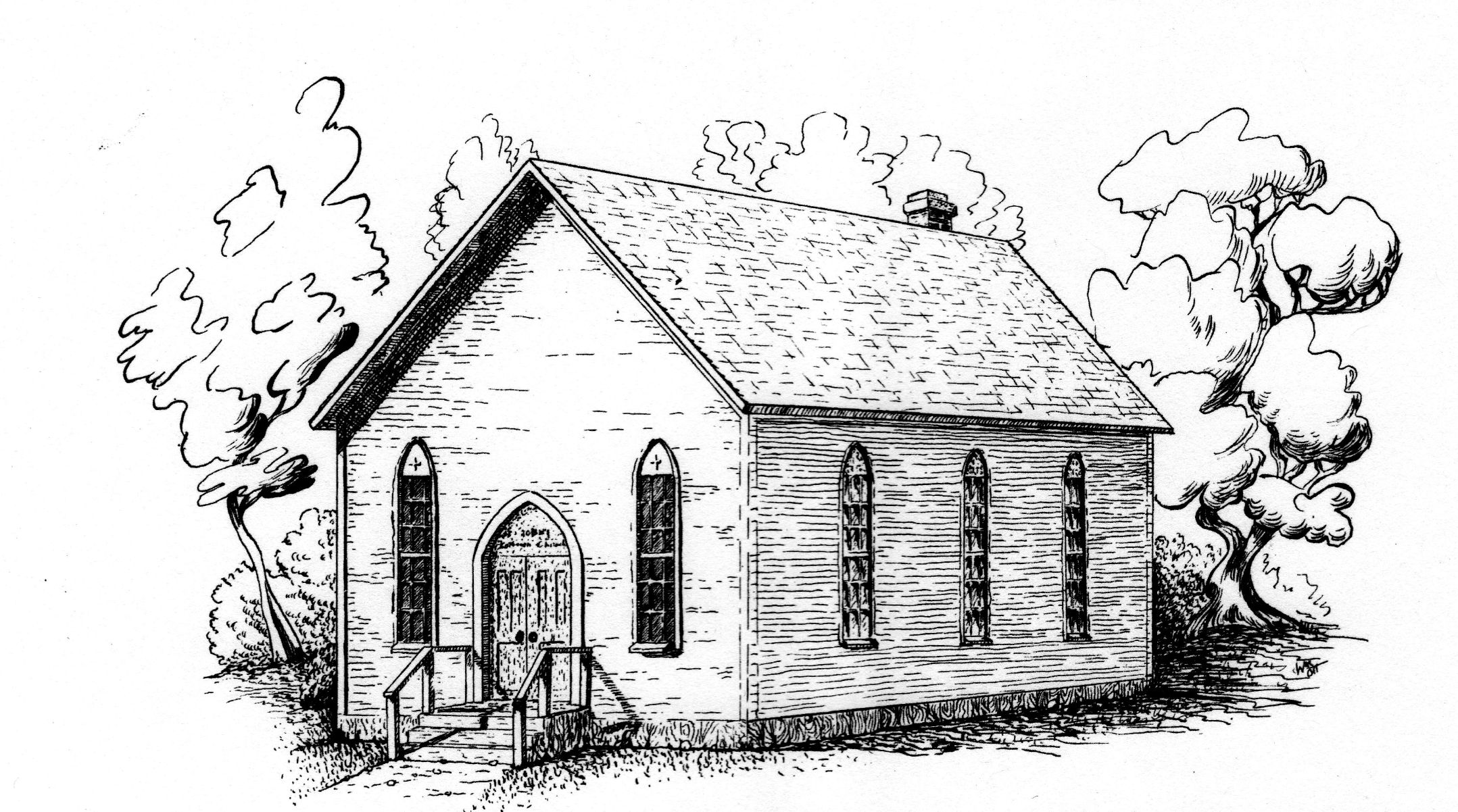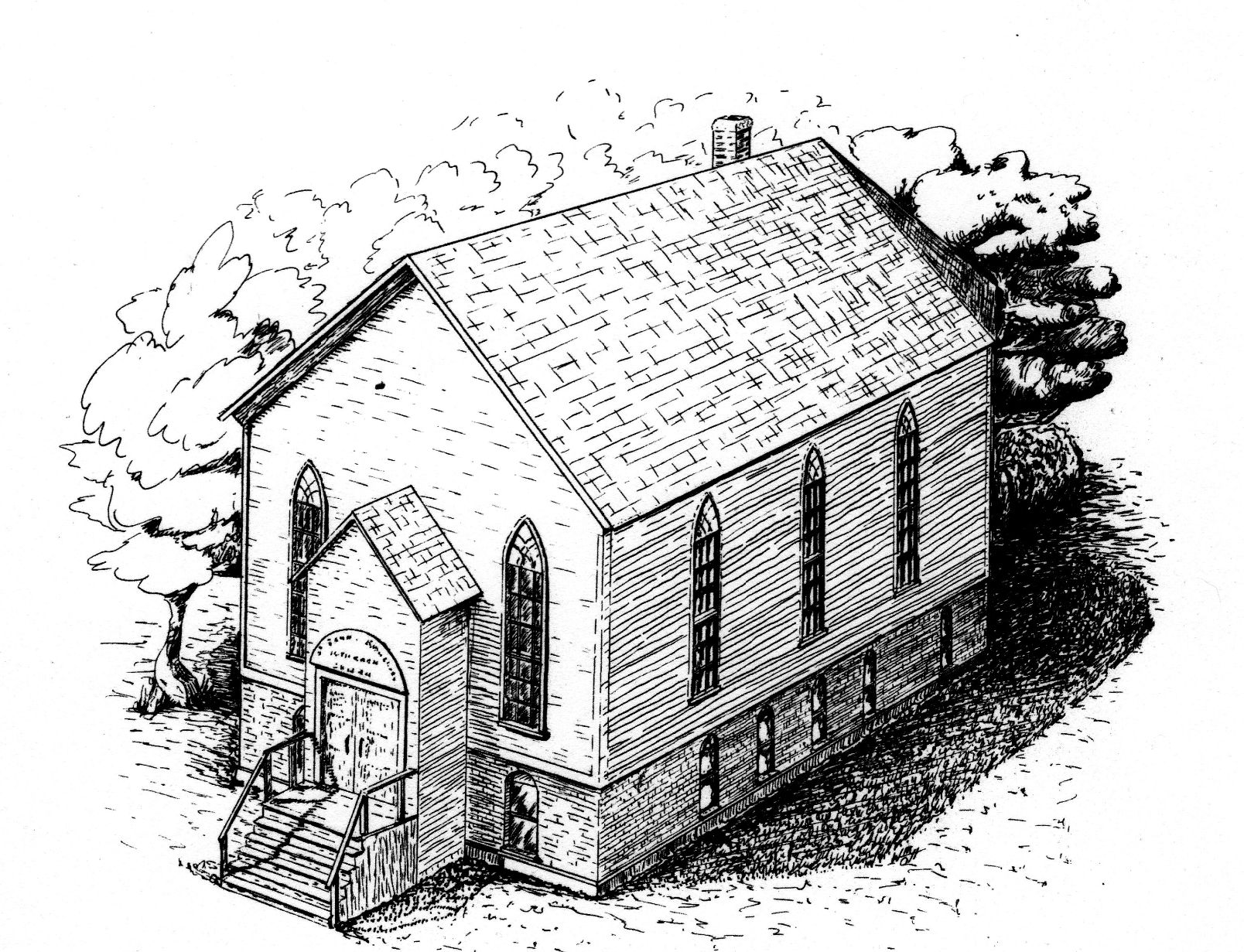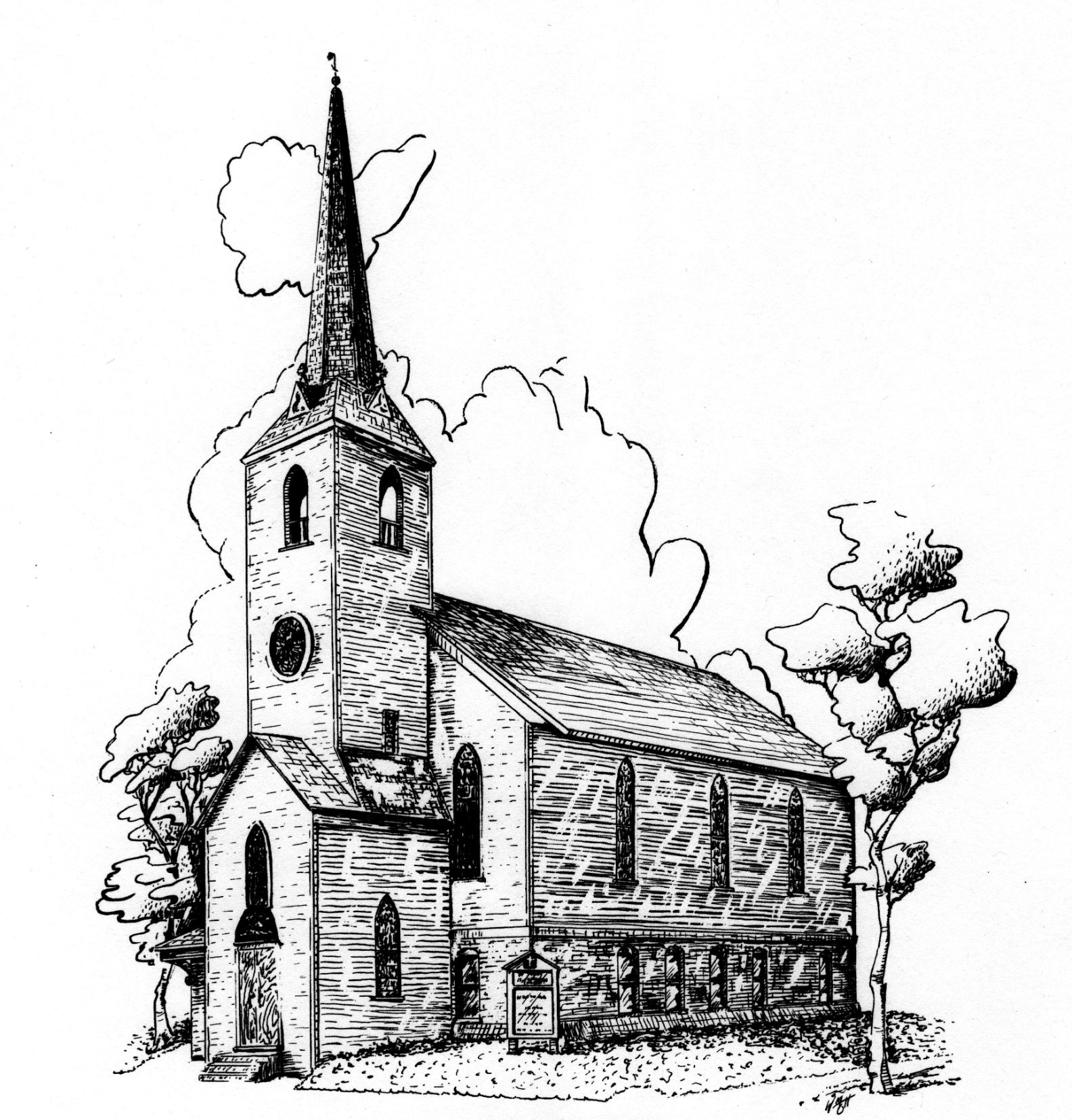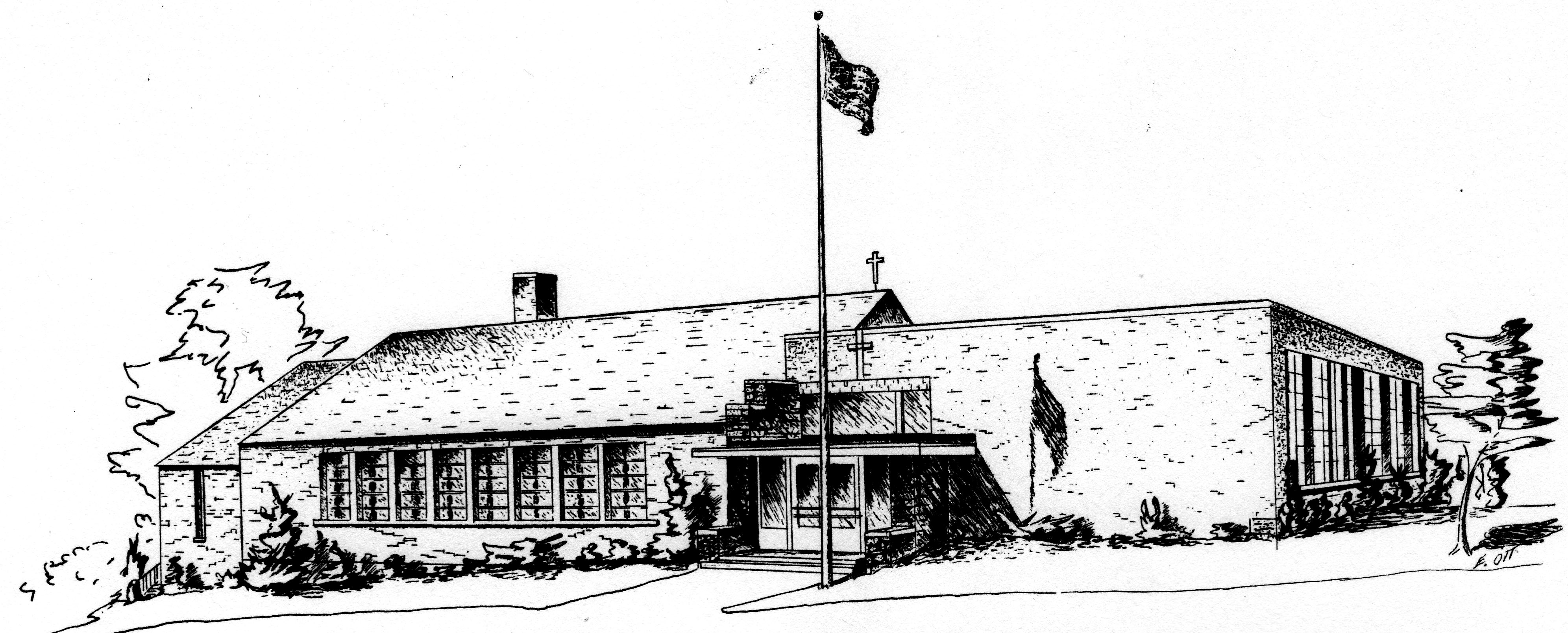





1867 - St. John's Lutheran Church - 1883 and 1895

1950 St. John's Christian Day School
Early History of St. John's Lutheran Church
Grand Haven, Michigan
1863 - 1959
|
We thank our Heavenly Father for His sustaining providence. We thank the Holy Spirit for His guidance to those whose labors laid so firm a foundation for St. John's Lutheran Church. We thank Jesus Christ our Saviour for the opportunity to share in the expansion of His Kingdom here on earth. Prior to 1821 the inhabitants of this area were the Indians who found the hunting and fishing in the vast wilderness to their liking. They probably sold their excess furs to the occasional trader who passed through. In 1821 Rix Robinson set up the first permanent trading post on the banks of the Grand river. In 1834 the Rev. William M. Ferry established the first settlement in the area, and this is generally regarded as the birth date of Grand Haven. It was in 1863 on the 21st day of May that the Rev. William Achenbach began to preach to the Lutherans in the Grand Haven area. pastor Achenbach, at that time, was the resident Pastor of Immanuel Lutheran Church in Grand Rapids. He came to Grand have at the request of the Lutherans in the area. It is probable that those early services were held in the home of a member of that original group. Pastor Achenbach later in 1863 succeeded by the by the Rev. J. L. Daib as Pastor of Immanuel. Pastor Daib continued to serve the Grand Haven area through 1863 and 1864. He held services here every eight weeks and it is probable he made the journey from Grand Rapids on one of the several river boats that operated between the two cities at that time. It was through the efforts of Pastor Daib that steps were taken to formally organize the Grand Haven group into a Lutheran congregation. A constitution was drawn up and after due consideration the final acceptance was made on October 1, 1865. With this action St. John's became affiliated with the Missouri Synod. Rev. Daib could now be installed as Pastor of the congregation. (It was in 1863 that the congregation had extended a call to him but the installation did not take place until January 10, 1866.) This service was held in the large room of the court house in Grand Haven. Pastor Daib thus became the first official Pastor of St. John's Lutheran Church, though he continued to serve here as a non-resident Pastor. On April 8, 1866, twenty-seven charter members signed the constitution. The delay between acceptance and signing was due to the busy schedule of Pastor Daib and because he had not had time to properly enter the constitution in the record book. It was at this same meeting the first officers of the congregation were elected. They were seven in number: John Behm, William Baehre, Jr., Fred Stelling, H. C. Bare, M. Viebrock, John Zietlow and Charles T. Pagelson. Of interest is the fact that the first entries in the record book are in English. Then on page 6 of Volume 1 we find the following note: "As the congregation is German it was thought proper and so ordered that the following constitution and further transactions of the St. John's congregation aforesaid should be recorded in the German language." Thereafter until in the 1920's all records of the church are in the German language. At the April 8, 1866 meeting is was resolved to gather funds to erect a church. By May 13, $516.00 had already been received and in the following week an additional $216.00 was donated. A lot was purchased near the edge of town on the corner of Sixth and Franklin Streets. In August, the contract for the church building was let, the total amount being $290.00. In September of the same year contracts were let for the finishing of the interior of the building for $214.00. By November plans were being made for dedication. On December 8, 1867, St. John's Lutheran Church building was dedicated to the Glory and Service of God. Two services were held on that eventful day. The morning service was in German with Rev. Schmidt of Chester speaking. The afternoon service was in English and was conducted by Rev. Walter of Wyandotte. The church was well filled for these services and benches had to be borrowed from the court house to accommodate the large gathering. Members from Crockery Creek and Spring Lake were unable to attend because of ice in the Grand river, which was too thick to ply by boat and too thin to cross by foot. Even this early in our church the ladies were active. They supplied the Altar and Pulpit paraments which were used for the first time on dedication Sunday. Of interest is the fact that this first Lutheran church building, though added to through the years, still stands at the corner of Sixth and Franklin Streets. In 1868 the members of the Episcopal Church asked if they could rent our building for their services. The voters allowed them to use the building at no charge. The first confirmation service in Grand Haven was held in 1869. Prior to this time the confirmations were held in Grand Rapids. By 1970 Pastor Daib felt that the congregation could support a resident Pastor. At the request of the voters he wrote to the President of Synod for a list of candidates. At the same time he urged the congregation to build a parsonage. In June 1970 a call was extended to the Rev. A. M. kaehler of Berlin, PA. The salary was $400 per year plus parsonage and fuel. Rev. Kaehler accepted and was installed in July, 1870. He thus became the first resident Pastor of St. John's. Pastor Kaehler held services her and in the "Bush". In the "Bush" was a reference to the group of Lutherans in Grand Haven Township who later were to form Immanuel Lutheran Church of Agnew. This was our first congregation. In July, 1870 the congregation let to Behm and Moll to build a parsonage. The total cost of this contract was $185. The parsonage was to be built on the north of the church. A call was extended to the Rev. F. Spindler in October, 1970. Rev. Spindler accepted and was installed in February, 1871. Pastor Spindler came to the congregation in the "Bush" and called on the Blendon group once every six weeks. Blendon was the second daughter congregation. In October, 1871 the Grand Haven group decided to form their own congregation. They built a new church and in 1872 the dedication of Immanual Church took place. The congregation's first organ was purchaed in 1872 at the cost of $185.00. The school was started in 1875. It is probable that this first school was held in the parsonage. This first attempt was not very successful for it was a short time later that the school was dropped. Pastor Spindler preached his farewell sermon on March 26, 1880, and in June of the same year a call was extended to the Rev. W. Burmeister. He accepted and was installed on August 22, 1880. At this time the interior of the church was redecorated and new carpeting was laid. In 1881, after much urging from Pastor Burmeister, the day school was resumed. The day school was held in the Nave of the church. At about the same time a basement for school was discussed though no action was taken. A third daughter congregation, Trinity of Muskegon, began when Pastor Burmeister was allowed to have services there once every eight weeks. In 1882 a German Evangelical Church was organized in the city. Many members of St. John's left to join the new church. They stated that they were not in agreement with some of the practices of the Missouri Synod. Though many members left to join the new church, a large number of these were later to return to St. John's. In July of 1883 it was decided to build the church basement for school. While not much is known about this project it is probable that the basement was completed before December of the same year. It was in December that M. G. Hubert constructed twenty school benches at a cost of $2.00 each and donated an additional eight. It is evident from reading the records that much emphasis is placed on Christian education. it is also evident that the day school grew under the guidance of Pastor Burmeister, who was the day school teacher. On Easter Sunday in 1885, the dedication of a new Altar and Pulpit took place. Mr. Hubert had built and presented these items to the congregation. In 1889 pastor Burmeister asked for an organist. He stated that it was becoming too much for him to preach, teach, and play the organ, too. It is not stated what action was taken on this request except that in March a bellows pump was obtained for the organ. It was suggested that a youth be employed at 50c a month to operate the bellows. On November 2, 1890 Pastor Burmeister accepted a call to Christ Church, St. Louis, Missouri. He gave his farewell sermon in the same month. A call was extended to the Rev. E. Brueggemann, who accepted and was installed on January 26, 1891. After a short stay he asked for his release because of his health. He was peacefully released and preached his farewell sermon November 3, 1893. In November of 1893 Rev. M. Toewe was called. He accepted and was installed on December 10, 1893. In July of 1895 a contract was made to R. Moll for the erection of the tower. The amount of this contract was $662. In September, 1895, the ladies proposed the purchase of bells for the tower. The voters decided the congregation should buy them. The bells were cast in Wisconsin at a cost of $288. On October 6, 1895, the tower was dedicated. In 1896 the "----orter" catechism was introduced here by Pastor Toewe. Our Pastor preached every fourth Sunday at Pigeon Creek. In 1898 electric lights were installed in the church at the urging of the Ladies Aid. In 1901 the Grand Haven Public School board asked to rent the basement of the church for classes. It was agreed to rent the basement to the public school for $10 per month. The Christian day school had not been active during Pastor Toewe's stay here. Pastor Toewe left St. John's in April of 1904. Pastor Smith from Blendon served our congregation as vacancy pastor for the remainder of 1904. Rev. A. Schultz who had been extended a call accepted and was installed in January of 1905. It was under Pastor Schultz that the first regular English services were scheduled. These were held twice a month on Sunday evenings. Through out the early 1900's under Pastor Schultz, St. John's continued to grow. The introduction of English in the services was significant in that it indicates that the second generation was coming into influence in the congregation and that "Old Country" ties were being broken. This was the beginning of a transition period that was to last for many years, for it would be almost a half a century before St. John's was no longer referred to as that "German Church on the Hill". Pastor Schultz left St. John's in 1910. In the next year the Rev. J. Hoeness was called and installed. Pastor Hoeness was to serve the congregation until his death in 1925. It was during Pastor Hoeness's time the Sunday School took on importance and began to grow. In April of 1926 the Rev. A. O. Meyer became our Pastor. He was shortly thereafter to marry Miss Alma Gieseking. It was about this time that the basement of the church was completely remodeled and equipped for Sunday School and religious instruction classes. A few years later the nave of the church was redecorated and a pipe organ installed. Also new pews were purchased for the church. In 1929 the present parsonage at 1015 Franklin Street was purchased. Later in the same year the old parsonage was sold and razed. At this time English services were held every Sunday along with a German service. In the lat 1930's German services were held one every two weeks. Under Pastor Meyer the Walther League was established here and flourished. It was late in 1940 Pastor Meyer left St. John's to organize a congregation in the Greater Detroit area. In1941 the Rev. Victor Felten accepted our call and became our Pastor. During his pastorate in 1946 plans for a school began to take concrete form. The present church and school property was purchased at that time at a total cost of $4300. It was also in 1946 that a call was placed for a day school teacher. Mr. R. W. Scheer accepted and was installed as principal of the day school and Minister of Sacred Music on August 18, 1946. On September 4, 1946, after a period of over forty years the day school at St. John's once again was in operation. It was held in the basement of the church and had an enrollment of thirty-eight children. The classes were from kindergarten thru the fifth grade. Mr. Scheer was the teacher. He was assisted by Pastor Felten. In January of 1947 plans were being drawn for a new school to be located on the lots on Taylor Avenue. In 1947 a sixth grade was added to the day school and the enrollment was over fifty for the 47-48 school term. The streets and sewers were put in at our property in the fall of 1947. In 1948 a second teacher was called. Mr. Robert Merkling accepted and was here for the fall term. Ground breaking for the new school took place on September 26, 1948; however construction did not start immediately because financing had not been completed. On October 9, 1949, the cornerstone laying took place for our new school. Plans had been revised and financing obtained so that the school building was finally under construction. On November 27, 1949, Pastor Felten preached his farewell sermon as he had accepted a call to Pueblo, Colorado. A call was extended to the Rev. Robert E. Brege. he accepted and was installed on March 12, 1950. It was decided by the voters that services would be held in the school building and that the old church would be sold. On June 25, 1950, St. John's Lutheran Church and Parish School were dedicated to the Service and Glory of God. September of 1950 school was held in two of the classrooms for the first time. For the school term of 1951 the third classroom was furnished. In 1954 plans were made to campaign to raise funds to eliminate the indebtedness on the school building and to build a new church. The campaign was a success with the members of St. John's pledging over $96,000 to the building fund payable over a three year period. In the same year the voters appointed a planning committee whose job it was to secure plans for a new church building. After meeting with several architects the committee selected Lester A. Trier, Structural Engineer of Elkhart, Indiana, to prepare the drawings for our new church. On June 5, 1955, Pastor Brege preached his farewell sermon. He had accepted a call to Concordia Luther Church, Springfield, Illinois. On August 7, 1955 the Rev. Edward Hilst was installed as our Pastor. In October, 1955 the plans and drawings of the new church were present to the congregation for approval. With the acceptance of the plans the planning committee became the building committee which began to plan for the actual construction of the new church. In August, 1956 the mortgage on the school building was burned. Thus in a period of ten years from the reestablishing of our day school to the building of our school parish house, we had paid off an indebtedness of over $100,000. We were now debt free and could concentrate on raising funds for a new church. On January 9, 1957, St. John's congregation was deeply saddened when Pastor Hilst was suddenly called home by the Lord. The heartfelt grief of the members clearly showed how deeply he had become endeared to the congregation. He will long be remembered for his fine sermons, his winning personality, and his boundless energy in his ministry for Christ here at St. John's. A call was extended to the Rev. Cecil A. Klages. He accepted and on May 17, 1957, he was installed as Pastor of St. John's. October of 1957 saw the opening of another campaign to raise funds for the new church. In four weeks' time the members of St. John's had pledged over $100,000 payable or a three year period for the new building. With this overwhelming support the building committee began to finalize the church plans and specifications and took steps to secure a loan so that construction could begin. On April 13, 1958 ground breaking services were held for the new church. July 21st the same year saw the laying of the cornerstone. On June 7, 1959, the new church was dedicated to the Service and Glory of the Triune God. |
Transcriber: ES
Created: 10 Nov 2011